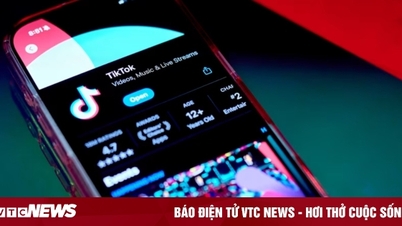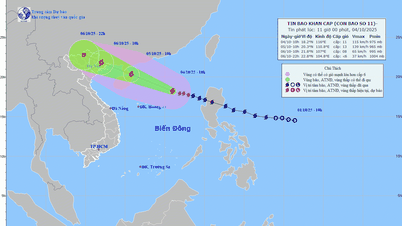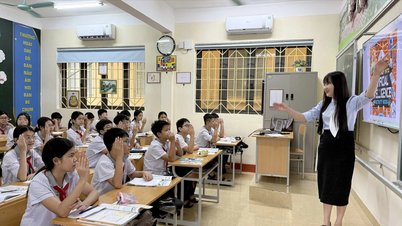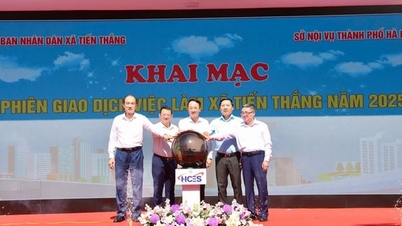On the evening of September 16, at 6:30 p.m. Vietnam time, the World Intellectual Property Organization (WIPO) held a ceremony to announce the Global Innovation Index (GII) Report 2025 in Geneva (Switzerland). Accordingly, Vietnam was ranked 44/139 countries and economies , maintaining its ranking in 2024.
In particular, in 2025, Vietnam will be the world leader in exporting creative goods for the first time, and will continue to lead in the two indexes of high-tech imports and high-tech exports. Some other indexes also achieved high positions such as: labor productivity growth rate (ranked 4th), number of smartphone applications created (ranked 7th), and the proportion of R&D expenditure covered by enterprises (ranked 8th).

Mr. Daren Tang - Director General of WIPO - at the launching ceremony of the Global Innovation Index 2025 report. (Screenshot)
Specifically, the report said that Vietnam continued to improve its innovation input ranking by 3 places compared to 2023, from 53rd to 50th (innovation input includes 5 pillars: Institutions, Human resources and research, Infrastructure, Infrastructure, Business development level).
Innovation output still has a better ranking than innovation input, although the ranking decreased by 1 place compared to 2024, from 36th to 37th (innovation output includes 2 pillars: Knowledge and technology products, Creative products).
According to the GII Report, Vietnam maintains its 2nd position in the group of lower-middle-income countries.
In the ASEAN region, Vietnam surpassed Thailand, ranking 3rd after Singapore and Malaysia.
In the GII 2025 Report of WIPO, Vietnam was recognized by WIPO as one of the 9 middle-income countries that improved their rankings the fastest since 2013 (including China, India, Vietnam, Philippines, Indonesia, Iran, Morocco, Albania and Turkey). Vietnam is also one of 2 countries that hold the record of having outstanding achievements compared to the level of development for 15 consecutive years (including India and Vietnam).

WIPO Innovation Index rankings since 2013. (Screenshot)
In the input group, many indicators improved significantly: Stability of business environment policy increased by 14 ranks (rank 28), effectiveness of law enforcement increased by 5 ranks (rank 67), average tariff increased by 28 ranks (rank 20), domestic production diversity increased by 10 ranks (rank 13), the rate of female workers with high technical qualifications increased by 7 ranks (rank 81), the rate of co-publishing research between institutes - schools - enterprises increased by 15 ranks (rank 51).
In the output group, many indicators also improved positively: The number of PCT patent applications increased by 17 ranks (rank 74), spending on computer software increased by 7 ranks (rank 56), the complexity of production and export increased by 9 ranks (rank 52), the number of ISO 9001 certificates increased by 4 ranks (rank 58), the density of intangible assets increased by 3 ranks (rank 54), the number of source code edits on Github increased by 8 ranks (rank 48).
Despite the progress, Vietnam still has some weaknesses that need attention. In the institutional pillar, the quality of legal regulations ranked only 95th, the effectiveness of law enforcement was 67th. In the education sector, education spending (as a % of GDP) fell 10 places to 116th, the secondary school student/teacher ratio ranked 107th, and the ability to attract international students was low (108th).
In the infrastructure pillar, the ICT index group is still limited with a rank of 69, of which ICT access is ranked 77, ICT use is ranked 54. The ecological sustainability index has dropped sharply, GDP/energy unit is ranked 73 and the low-carbon energy ratio is ranked 58. The investment index group dropped 12 places to rank 62, of which venture capital did not improve, microcredit fell to rank 58.
In the output group, the number of scientific and technical publications (rank 105), ICT service exports (rank 103) and royalties and licenses (rank 112) were all at low levels. In the creative field, cultural service exports fell 14 places (rank 95), and feature film production fell 11 places (rank 87).
The GII 2025 results show that Vietnam continues to effectively utilize resources to create innovation results exceeding development levels, while affirming the important role of science, technology and innovation in economic growth. In the context of global innovation facing many crossroads, maintaining and improving rankings is an important basis for Vietnam to continue to improve policies and enhance national competitiveness in the coming period.
The Global Innovation Index (GII) is published annually by WIPO. This is a prestigious toolkit for assessing national innovation capacity in the world, reflecting the socio-economic development model based on science, technology and innovation of countries. Thereby, countries can see the overall picture as well as their strengths and weaknesses.
For the above reasons, the GII is used by many governments as an important reference tool for state management of Science, Technology and Innovation, as well as for building science, technology and innovation policies (India, China, Philippines, Columbia, Brazil, etc.).
According to WIPO's 2024 survey results, 77% of member states (an increase of more than 20% compared to the 2022 survey results) use GII results in developing science, technology and innovation strategies and policies.
In recent times, the Government has used this index as one of the important management tools and has assigned ministries, agencies and localities to jointly take responsibility for improving the index. In particular, the Ministry of Science and Technology is assigned to be the focal point for general monitoring and coordination.
From 2017 to present, Vietnam's GII index has continuously improved, increasing from position 59 (in 2016) to 44 in 2024/133 countries and economies.
Source: https://vtcnews.vn/viet-nam-dung-dau-the-gioi-ve-xuat-khau-hang-hoa-sang-tao-ar964267.html



![[Photo] General Secretary To Lam attends the 8th Congress of the Central Public Security Party Committee](https://vphoto.vietnam.vn/thumb/1200x675/vietnam/resource/IMAGE/2025/10/4/79fadf490f674dc483794f2d955f6045)
![[Photo] Solemn opening of the 8th Congress of the Central Public Security Party Committee, term 2025-2030](https://vphoto.vietnam.vn/thumb/1200x675/vietnam/resource/IMAGE/2025/10/4/f3b00fb779f44979809441a4dac5c7df)





















![[Photo] Bustling Mid-Autumn Festival at the Museum of Ethnology](https://vphoto.vietnam.vn/thumb/1200x675/vietnam/resource/IMAGE/2025/10/4/da8d5927734d4ca58e3eced14bc435a3)
![[Infographic] Notable numbers after 3 months of "reorganizing the country"](https://vphoto.vietnam.vn/thumb/1200x675/vietnam/resource/IMAGE/2025/10/4/ce8bb72c722348e09e942d04f0dd9729)



























































Comment (0)